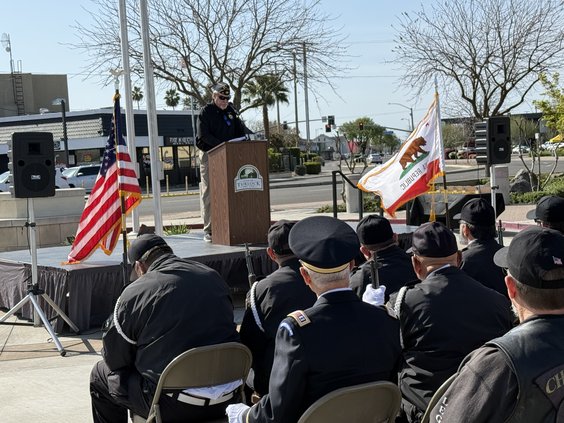Just like current fashion trends and music, the 90s are returning.
The current heat wave that has seen temperatures soar to 114 degrees in Turlock and stress the state’s electrical grid is expected to finally break on Saturday when the forecasted temperature is 97 degrees, followed by a downright pleasant 90 degrees.
Tuesday marked the seventh consecutive day the state’s grid operator, the California Independent System Operator called a Flex Alert. The alerts urged consumers to reduce their energy consumption between 4 p.m. to 9 p.m. to help reduce stress on the statewide power grid. A series of days of record-high temperatures created an enormous demand for energy to power air conditioners, among other challenges.
Daily Highs in Turlock
Sept. 1 — 104 °F
Sept. 2 — 104 °F
Sept. 3 — 103 °F
Sept. 4 — 105 °F
Sept. 5 — 111 °F
Sept. 6 — 114 °F
Power outages were reported Tuesday in Ceres, including at two cooling centers there.
It could not be confirmed whether the excessive heat, which reached a high of 114 degrees, according to the National Weather Service, was the cause of the outages.
According to the TID website, outages were first reported in the Ceres-Keyes-Hughson area at around 2:30 p.m. Tuesday.
The Walmart Supercenter in Ceres, 3960 Mitchell Rd., was without power, as were two cooling centers. Power was restored to those locations within an hour.
According to Constance Anderson, TID’s communications division manager, Tuesday was expected to be the peak for energy demand during this heat wave, and marked the sixth consecutive day with temperatures reaching 100-pus degrees.
“Multiple days of extreme heat takes a toll on our infrastructure and can cause isolated outages,” said Anderson. “We encourage customers to be prepared, keep their devices charged, and have plenty of water on hand.
“If someone should experience an outage, visit www.TID.org/outages for updates or call our 24-hour service line at 209-883-8301.
Energy loads in the TID service area will remain high throughout the week, and customers are encouraged to conserve power when they can.
“Choices like playing a board game rather than turning on the TV, and waiting to do things like running the dishwasher, doing laundry or charging your EV will help limit the potential impact to TID’s grid,” said Anderson.
Tuesday was among the most challenging days ever for the state’s energy grid. CAISO forecasted Tuesday’s peak statewide electricity demand to be 50,087 megawatts, which is just below the record of 50,270 MW set in 2006.
“This is an extraordinary heat event we are experiencing, and the efforts by consumers to lean in and reduce their energy use after 4 p.m. are absolutely essential,” said Elliot Mainzer, the California Independent System Operator’s president and CEO. “Over the last several days we have seen a positive impact on lowering demand because of everyone’s help, but now we need a reduction in energy use that is two or three times greater than what we’ve seen so far as this historic heat wave continues to intensify.”
The ISO declared an Energy Emergency Alert 1 (EEA) Monday morning. That emergency designation signals to utilities and consumers that all resources are committed or forecasted to be in use, and that energy deficiencies are expected. As they monitor a host of factors including wildfires and generator availability, grid operators will determine if the emergency notifications need to be elevated to an EEA 2 or beyond.
EEA 2 would trigger deployment of a suite of emergency tools designed to keep supply and demand for the power system balanced during extreme conditions, and potentially freeing up to a few thousand megawatts of additional resources. If conditions continue to deteriorate, an EEA 3 may be declared. If reserves are then exhausted CAISO would instruct utilities in its service area to manage shedding load.
Utilities make the determination of how best to spread and rotate the outages across their service territory, with the goal of keeping them as short as possible. For two days in August 2020, outages affecting about 800,000 homes and businesses lasted anywhere from 15 minutes to about 2½ hours, marking the first time outages were ordered in California due to insufficient supplies in nearly 20 years.
“We never want to get to that point, of course,” Mainzer said, “but we want everyone to be prepared and understand what is at stake. We can’t control the weather, but we really can bend the demand curve and get through this successfully if everyone doubles down and reduces their energy use as much as possible.”
The continued high temperatures poses serious health risks, especially for those that are considered more vulnerable, like the elderly, young children and those with certain medical conditions. But once it gets to a certain level, like what has been seen over the last several days, it becomes a health risk for everyone. The National Weather Service has the HeatRisk index for most of the state in the magenta zone, which means there is a very high health risk for everyone because of the prolonged high heat exposure and very little relief coming overnight. The index does not have anything higher than magenta.
Extreme heat can cause people to suffer from heat-related illness, and even death because their bodies cannot properly cool down. More than 700 people die from extreme heat every year in the United States, according to the Centers for Disease Control and Prevention.
The CDC recommends people take these steps when temperatures are extremely high:
· Stay in an air-conditioned indoor location as much as you can.
· Drink plenty of fluids even if you don’t feel thirsty.
· Schedule outdoor activities carefully.
· Wear loose, lightweight, light-colored clothing and sunscreen.
· Pace yourself.
· Take cool showers or baths to cool down.
· Check on a friend or neighbor and have someone do the same for you.
· Never leave children or pets in cars.
· Check the local news for health and safety updates.
Under these extreme conditions, wildfire smoke could drive air quality up to unhealthy levels. Poor air quality can trigger asthma attacks, aggravate chronic bronchitis, and increase the risk of heart attack and stroke. Individuals with heart or lung disease should follow their doctors’ advice for dealing with episodes of particulate matter exposure. Those with existing respiratory conditions, including COVID-19, young children and the elderly, are especially susceptible to the health effects from this form of pollution, according to the San Joaquin Valley Air Pollution Control District.
Some industries, like construction and yard maintenance can shift around work schedules to keep employees out of the hottest times of the day, but other sectors, like that of public safety, can do little but grin and bear it.
“As for managing heat stress, we try to minimize exposure as best we can,” said Chris Jelinek, the Deputy Chief of Turlock Fire. “Training activities are either done first thing in the morning when it’s cool, or kept indoors. For fires and other significant incidents, we really emphasize incident rehabilitation and when guys are not actively fighting fire or doing other emergency work, we keep them in the shade and allow them to hydrate and stay cool. Also, the incident commander will often times order additional engine companies so that we can rotate more crews in to do the work and minimize their impact of working in a high heat environment as best we can.”
Cooling centers are open at the Roger K. Fall Transit Center at 1418 N. Golden State Boulevard from 6 a.m. to 9 p.m. Monday through Friday and 9 a.m. to 7 p.m. Saturday; Turlock Public Library at 550 Minaret Avenue from 10 a.m. to 6 p.m. Monday, Tuesday and Thursday; noon to 8 p.m. Wednesday and 10 a.m.to 5 p.m. Saturday; and the Denair Public Library at 4801 Kersey Road from noon to 6 p.m. Monday through Thursday.
— Joe Cortez contributed to this report.









